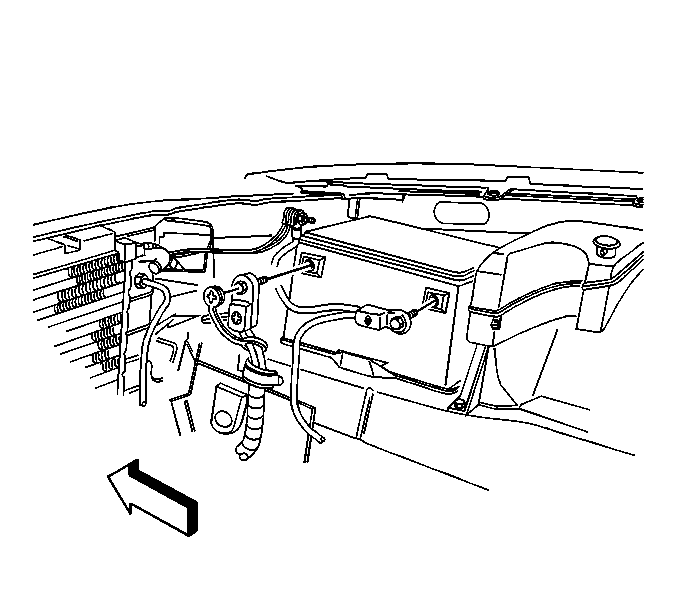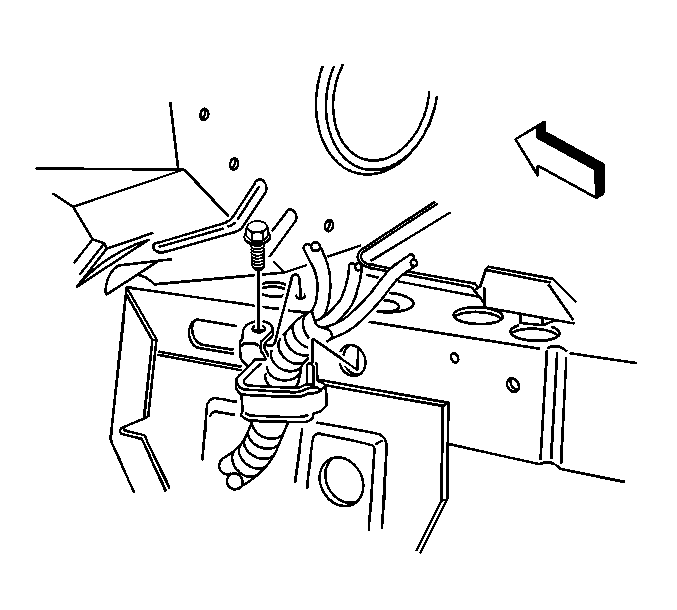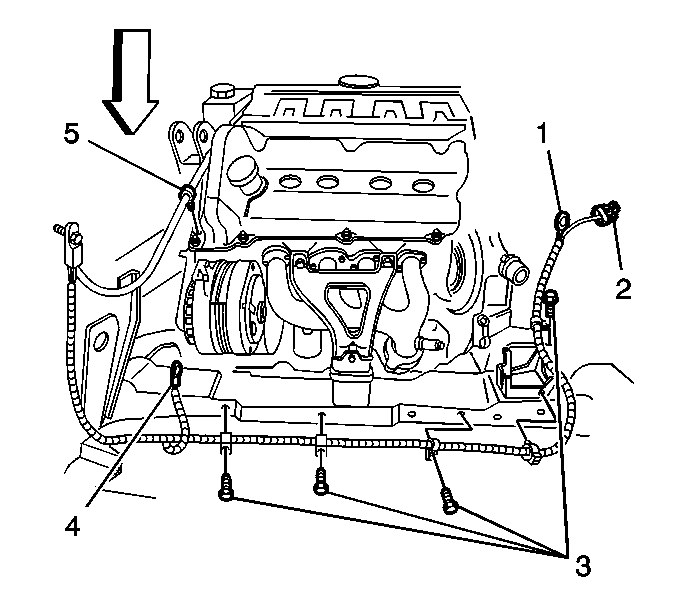Removal Procedure
| • | Always use replacement cables that are of the same type, diameter and length of the cables that you are replacing. |
| • | Always route the replacement cable the same way as the original cable. |
- Disconnect the battery negative cable from the battery.
- Disconnect the battery positive cable from the battery.
- Remove the bolt attaching the cable harness retainer to the body rail.
- Remove the intake manifold. Refer to Intake Manifold Replacement in Engine Mechanical-4.6L.
- Disconnect the battery positive cable from the starter.
- Disconnect the cable harness clip (5) from the camshaft cover.
- Remove the engine splash shield. Refer to Engine Splash Shield Replacement in Body Front End.
- Remove the generator output BAT terminal nut and disconnect the battery positive lead (4) from the generator.
- Remove the bolts (3) attaching the cable harness clips to the engine frame.
- Disconnect the positive battery cable (1) from the underhood fuse block.
- Remove the battery positive cable from the vehicle.

Caution: Unless directed otherwise, the ignition and start switch must be in the OFF or LOCK position, and all electrical loads must be OFF before servicing any electrical component. Disconnect the negative battery cable to prevent an electrical spark should a tool or equipment come in contact with an exposed electrical terminal. Failure to follow these precautions may result in personal injury and/or damage to the vehicle or its components.


Installation Procedure
- Place the positive battery cable into the cable harness clips along the engine frame.
- Connect the battery positive cable (1) to the underhood fuse block.
- Connect the battery positive lead (4) and install the generator output BAT terminal nut.
- Install the engine splash shield. Refer to Engine Splash Shield Replacement in Body Front End.
- Connect the cable harness clip (5) to the camshaft cover.
- Connect the battery positive cable to the starter.
- Install the intake manifold. Refer to Intake Manifold Replacement in Engine Mechanical-4.6L.
- Install the bolt attaching the cable harness retainer to the body rail.
- Connect the battery positive cable to the battery.
- Connect the battery negative cable to the battery.

Notice: Use the correct fastener in the correct location. Replacement fasteners must be the correct part number for that application. Fasteners requiring replacement or fasteners requiring the use of thread locking compound or sealant are identified in the service procedure. Do not use paints, lubricants, or corrosion inhibitors on fasteners or fastener joint surfaces unless specified. These coatings affect fastener torque and joint clamping force and may damage the fastener. Use the correct tightening sequence and specifications when installing fasteners in order to avoid damage to parts and systems.
Tighten
Tighten the cable harness clip retaining bolts (3) to 6 N·m (53 lb in).
Tighten
Tighten the battery positive cable to underhood fuse block nut to 11 N·m (97 lb in).
Tighten
Tighten the generator output BAT terminal nut to 12.5 N·m (111 lb in).
Tighten
Tighten the battery positive cable to starter terminal nut to 10 N·m (89 lb ft).

Tighten
Tighten the cable harness retainer bolt to 6 N·m (53 lb in).

Tighten
Tighten the battery cable to 17 N·m (13 lb ft).
Tighten
Tighten the battery cable to 17 N·m (13 lb ft).
